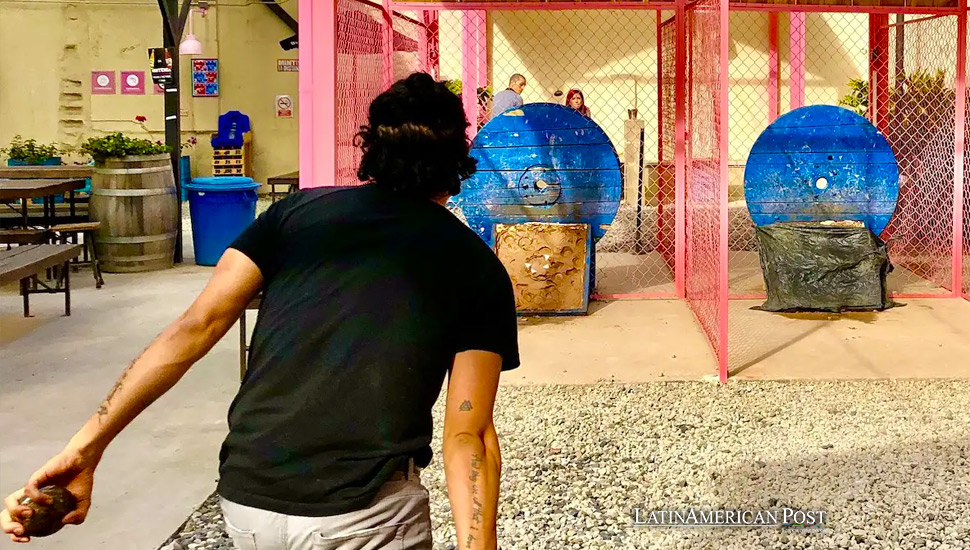The Rich History, Cultural Significance, and Explosive Appeal of Colombian Tejo

Beyond beer and explosive thrills, Colombian tejo transcends mere gamesmanship. It’s a cultural touchstone, weaving together history, community, and a love for good beer, offering a glimpse into the heart of Colombian life.
Colombia’s vibrant culture bursts forth in a symphony of sounds, sights, and tastes. Amidst the rhythmic salsa beats, the aroma of steaming coffee, and the breathtaking landscapes of the Andes lies a unique sport that captures the essence of Colombian life: tejo. More than just a game punctuated by the thrilling explosions of detonated gunpowder, Tejo is a cultural touchstone, weaving together threads of history, community, and a genuine love for good beer. This 1200-word exploration delves into the surprising origins of Tejo, its evolution into a national obsession, and significance in Colombian society today.
From Indigenous Ritual to Modern Pastime: Unveiling Tejo’s Ancient Roots
Tejo’s story stretches back centuries, tracing its lineage to the resourceful Muisca people who inhabited the Colombian highlands. Legends whispered when the Muisca used golden discs, known as “zepguagoscua,” in a ceremonial game that tested their throwing skills and strategic prowess. Over time, the game evolved, incorporating the explosive element of gunpowder into the mix. This unique adaptation might be attributed to the influence of Spanish conquistadors who arrived in the 16th century, bringing with them gunpowder technology. However, the explosive component added a layer of excitement and uncertainty – a perfect fit for the Colombian spirit.
The Ups and Downs of Tejo: A Story of Decline and Resurgence
Despite its ancient roots, tejo’s popularity fluctuated throughout history. Following the Spanish conquest, tejo faced a period of decline, possibly due to cultural suppression or changing societal priorities. However, the game’s spirit remained alive, particularly within rural communities where it continued to be played in backyards and local gatherings, and the latter half of the 20th century witnessed a remarkable resurgence of tejo. Urbanization and a growing national identity fueled a renewed interest in traditional pastimes like tejo. This resurgence wasn’t merely nostalgic; it reflected a desire to connect with Colombia’s rich cultural heritage and celebrate its unique traditions.
A tejo court, or “cancha de tejo,” is a rectangular lane typically made of packed clay. A wooden board is embedded into the clay at each end, holding a metal frame called a “bocín.” Within this frame, triangular paper packets filled with gunpowder, known as “mechas,” are arranged in a specific pattern. Armed with heavy metal discs called “tejos,” players take turns hurling them across the court, aiming to land the tejo within the designated area and detonate as many mechas as possible. The distance from the throwing line and the number of exploded mechas determine the score.
An Unbreakable Bond: Tejo, Beer, and Celebration
The essence of tejo goes beyond the technicalities of throws and scoring. It’s a social experience deeply intertwined with Colombian culture. A tejo match is often accompanied by a steady flow of ice-cold beer, with brands like Aguila or Club Colombia holding a special place in the Tejo experience. Games are also animated by lively music, delicious food, and a strong sense of camaraderie. Whether played amidst the rustic charm of a rural court or the vibrant atmosphere of an urban tejódromo (tejo hall), the sport brings together people from diverse backgrounds, fostering a sense of community and shared passion.
One of Tejo’s greatest strengths lies in its inclusivity. The equipment is inexpensive, and the rules are simple enough for anyone to pick up a tejo and take a shot. This accessibility fosters a sense of community and transcends social barriers. Generations often come together in tejo matches, grandparents teaching their grandchildren the art of the throw, and seasoned veterans sharing their strategies with newcomers. Furthermore, women’s participation in tejo is rising, with dedicated female leagues and tournaments gaining popularity. This shift challenges traditional gender roles and opens new avenues for women to participate in this iconic sport.
While tejo is primarily a recreational activity enjoyed by people of all ages and backgrounds, a growing competitive scene is taking shape. Talented players compete in regional and national tournaments, showcasing their throwing skills and vying for titles and prize money. Some top players have even garnered international recognition, pushing the boundaries of the sport and inspiring a new generation of tejo enthusiasts. The Colombian Tejo Federation (Federación Colombiana de Tejo – Fedetejo) is crucial in establishing and overseeing competitive play, ensuring fair rules, and promoting the sport’s development.
More Than a Game: Tejo’s Cultural Significance
Tejo transcends mere entertainment and embodies a vital piece of Colombian cultural heritage. It represents a connection to the country’s indigenous roots and symbolizes the enduring spirit of its people. In 2000, the Colombian government took a significant step by formally declaring tejo the national sport. This recognition elevates tejo within Colombian society and underscores its unique role in shaping national identity.
While tejo remains deeply rooted in Colombian soil, its popularity is slowly spreading to other parts of the world. Colombian immigrants have introduced the game to communities in Spain, the United States, and other corners of Latin America. The International Tejo Federation, with members across several continents, is working diligently to promote the sport and increase its global footprint. The federation envisions a future where tejo might even be featured in the Olympic Games, a testament to its growing international appeal.
Challenges and Preserving Tradition
Tejo has its challenges. The sport’s popularity creates concerns in densely populated urban areas, where limited space and noise restrictions can be an issue. In response, enthusiasts are exploring ways to adapt the game for smaller venues and reduce noise levels. The preservation of heritage is also a continuous journey. Initiatives to promote tejo in schools and the construction of dedicated sports facilities are helping to cultivate appreciation for the sport among the next generation.
To truly understand the heart of Colombian culture, one must experience the energy and passion of a tejo match. The roar of the crowd, the thrill of a perfectly executed throw, the clinking of beer bottles, and the shared sense of community transcend language barriers and create a profound connection to the vibrant spirit of Colombia. Those moments, captured within the clay court and fueled by the explosive joy of Tejo, make it more than just a sport – they represent the essence of a nation.




